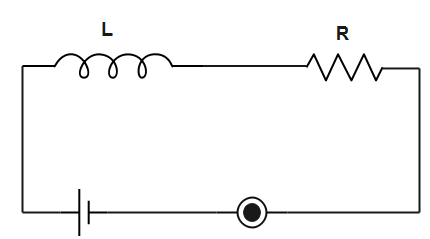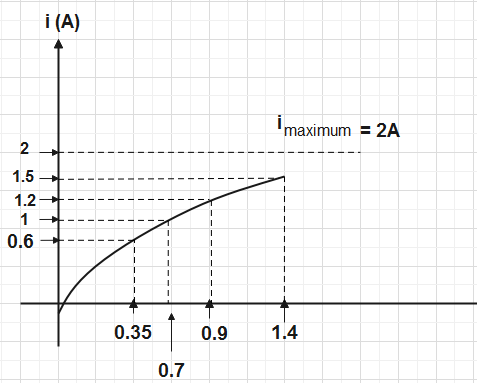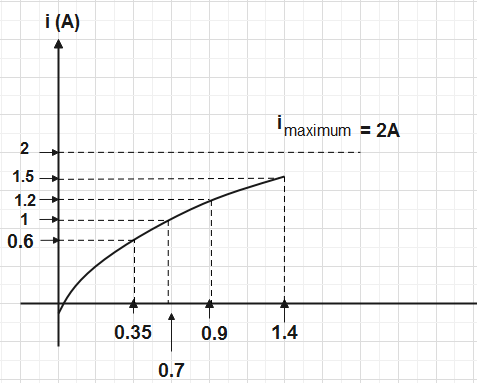
For L-R circuits, growth of current as a function of time $t$ is shown in the graph. Which of the following options represents the value of time constant most closely for the circuit?
(A). $0.7s$
(B). $1s$
(C). $2.4s$
(D). $0.4s$




Answer
527.4k+ views
Hint: The graph represents the relation between current and time interval. As the switch is turned on, a huge current flows through the circuit due to which the inductance comes into play. When the time interval is equal to the time constant, the value of current is equal to sixty seven percent of the maximum current. The time interval corresponding to this value of current is the time constant.
Formula used:
$\tau =\dfrac{L}{R}$
Complete step by step solution:
In an L-R circuit, when the switch is turned on, a huge current flows through the circuit. As the value of current changes with time, an opposite current flows through the circuit due to self inductance.
The time constant of a circuit is the ratio of the inductance to the resistance in a circuit. Therefore,
$\tau =\dfrac{L}{R}$
Here, $\tau $ is the time constant
$L$ is the inductance
$R$ is the resistance
When the time interval is equal to the time constant or $t=\tau $, the value of the current is $63%$ of the maximum current.

According to the graph, the maximum value of the current is $2A$. Let the value of current at time constant be $i$, then
$\begin{align}
& i=0.63\times 2 \\
& \Rightarrow i=1.26A \\
\end{align}$
Current $1.2A$ corresponds to $0.9s$, so we can say that current $1.26A$ corresponds to approximately $1s$ on the graph.
Therefore, the option which represents the time constant for the circuit most accurately is $1s$.
Hence, the correct option is (B).
Note: The unit of time according to the definition of time constant is $H{{\Omega }^{-1}}$ or seconds. It is assumed that a circuit reaches its steady state at t= infinity. At steady state, the current in the circuit becomes constant. The reactance of an L-R circuit is equal to the sum of squares of resistance and reactance.
Formula used:
$\tau =\dfrac{L}{R}$
Complete step by step solution:
In an L-R circuit, when the switch is turned on, a huge current flows through the circuit. As the value of current changes with time, an opposite current flows through the circuit due to self inductance.
The time constant of a circuit is the ratio of the inductance to the resistance in a circuit. Therefore,
$\tau =\dfrac{L}{R}$
Here, $\tau $ is the time constant
$L$ is the inductance
$R$ is the resistance
When the time interval is equal to the time constant or $t=\tau $, the value of the current is $63%$ of the maximum current.

According to the graph, the maximum value of the current is $2A$. Let the value of current at time constant be $i$, then
$\begin{align}
& i=0.63\times 2 \\
& \Rightarrow i=1.26A \\
\end{align}$
Current $1.2A$ corresponds to $0.9s$, so we can say that current $1.26A$ corresponds to approximately $1s$ on the graph.
Therefore, the option which represents the time constant for the circuit most accurately is $1s$.
Hence, the correct option is (B).
Note: The unit of time according to the definition of time constant is $H{{\Omega }^{-1}}$ or seconds. It is assumed that a circuit reaches its steady state at t= infinity. At steady state, the current in the circuit becomes constant. The reactance of an L-R circuit is equal to the sum of squares of resistance and reactance.
Recently Updated Pages
A man running at a speed 5 ms is viewed in the side class 12 physics CBSE

The number of solutions in x in 02pi for which sqrt class 12 maths CBSE

State and explain Hardy Weinbergs Principle class 12 biology CBSE

Write any two methods of preparation of phenol Give class 12 chemistry CBSE

Which of the following statements is wrong a Amnion class 12 biology CBSE

Differentiate between action potential and resting class 12 biology CBSE

Trending doubts
What are the major means of transport Explain each class 12 social science CBSE

Which are the Top 10 Largest Countries of the World?

Draw a labelled sketch of the human eye class 12 physics CBSE

How much time does it take to bleed after eating p class 12 biology CBSE

Explain sex determination in humans with line diag class 12 biology CBSE

Explain sex determination in humans with the help of class 12 biology CBSE




